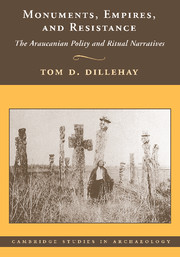Preface
Published online by Cambridge University Press: 27 July 2009
Summary
Much of the data in this book come in the form of archaeological research, ethnohistorical documentation, and ethnographical recordings and observations. For more than thirty years, I have participated in many different ritual ceremonies and other events in many different Araucanian, or Mapuche, communities, always examining the living behavior from the perspective of their spatial, material, and symbolic correlates. The Mapuche are not partial to interviews and prefer a non-interventionist style of fieldwork where they offered information when they thought that my colleagues and I were ready to receive it or needed to be corrected. My language skills in Mapundungun are barely sufficient for understanding the conversation at hand during daily life but certainly not proficient to understand the often archaic intonations and nuances of shamanic speech and chant in ceremony. Most interviews and rituals were tape recorded when we were given permission. A native speaker, Maria Catrileo, translated the tapes from Mapundungun to Spanish. For much of the material, I assisted in the translation of many words and phrases, now having become somewhat proficient in the ritual language. The majority of the Spanish texts, especially those from the early chroniclers, were translated by Patricia Netherly. Others were translated by other colleagues and by me. Netherly also edited these translations in order to derive a similar style.
Although the research themes examined in these pages encompass several centuries and primarily one river valley, the impetus for this book comes from my experiences in almost all parts of the Araucanian territory.
- Type
- Chapter
- Information
- Monuments, Empires, and ResistanceThe Araucanian Polity and Ritual Narratives, pp. xvii - xxPublisher: Cambridge University PressPrint publication year: 2007

